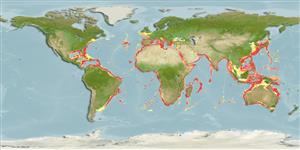Common names from other countries
Elasmobranchii (tubarões e raias) (sharks and rays) >
Squaliformes (Sleeper and dogfish sharks) >
Centrophoridae (Gulper sharks)
Etymology: Centrophorus: centr[um] (L.), prickle or sharp point; phorus, from phoreus (Gr.), bearer or carrier, referring to grooved spines on dorsal fins. (See ETYFish); granulosus: granum (L.), seed or grain; -osus, Latin suffix connoting fullness, referring to its granular brown skin. (See ETYFish).
More on authors: Bloch & Schneider.
Environment: milieu / climate zone / depth range / distribution range
Ecologia
marinhas batidemersal; intervalo de profundidade 50 - 1500 m (Ref. 247), usually 200 - 600 m (Ref. 247). Deep-water; 58°N - 43°S, 98°W - 156°E
Eastern Atlantic: France to South Africa, including the Mediterranean (Ref. 31367). Western Central Atlantic: northern Gulf of Mexico (Ref. 247, 6871). Indian Ocean: Mozambique, South Africa and the Aldabra Islands (Ref. 31367); Western Australia (Ref. 6871). Western Pacific: Japan, Papua New Guinea, and Australia (Ref. 31367). Not in the Eastern Pacific (Ref. 94782).
Comprimento de primeira maturação / Tamanho / Peso / Idade
Maturity: Lm ? range ? - ? cm
Max length : 170 cm TL macho/indeterminado; (Ref. 94782); 145.5 cm TL (female)
Espinhos dorsais (total) : 2; Espinhos anais: 0. Light grayish brown dorsally, paler ventrally; eyes greenish (Ref. 6871). Adults with tips of dorsal fins dusky, not prominently marked (Ref. 31367).
A common deepwater dogfish of the outer continental shelves and upper slopes, commonest below 200 m (Ref. 247); usually benthic and epibenthic at depths from 50-1440 m with most records from 200-600 m (Compagno, pers. comm. 07/07). Solitary (Ref. 26340). Adults feed mainly on bony fishes such as hake, epigonids, lanternfish, herring, smelts, cods, rattails, squid and crustaceans (Ref. 247, IUCN workshop 07/07). Males mature at about 105-118 cm TL (Ref. 94782). Ovoviviparous (Ref. 50449). Number of litter recorded, one in Mediterranean females, and possibly 1 or 2 for the species. This species is fished in Eastern Atlantic by bottom trawls, long lines, fixed bottom nets, hook and line and pelagic trawls; caught and discarded, or utilised from by-catch fisheries (IUCN discussion 07/07). Marketed smoked and dried salted for human consumption; also processed into fishmeal and a source of liver oil for squalene (Ref. 247). Maximum depth from Ref. 125614.
Ciclo de vida ou comportamento de acasalamento
Maturities | Reprodução | Spawnings | Egg(s) | Fecundities | Larvas
Ovoviviparous, embryos feed solely on yolk (Ref. 50449). Young are born from 30 to 42 cm or more (Ref. 247). Distinct pairing with embrace (Ref. 205).
Compagno, L.J.V., 1984. FAO Species Catalogue. Vol. 4. Sharks of the world. An annotated and illustrated catalogue of shark species known to date. Part 1 - Hexanchiformes to Lamniformes. FAO Fish. Synop. 125(4/1):1-249. Rome, FAO. (Ref. 247)
Status na Lista Vermelha da UICN (Ref. 130435)
CITES (Ref. 128078)
Not Evaluated
Ameaça para os humanos
Harmless
Uso pelos humanos
Pescarias: pouco comercial
Ferramentas
Relatórios especiais
Baixar XML
Fontes da internet
Estimates based on models
Preferred temperature (Ref.
115969): 7.7 - 17.3, mean 11.4 (based on 1031 cells).
Índice de diversidade filogenética (Ref.
82804): PD
50 = 0.5001 [Uniqueness, from 0.5 = low to 2.0 = high].
Bayesian length-weight: a=0.00219 (0.00169 - 0.00283), b=3.20 (3.12 - 3.28), in cm Total Length, based on LWR estimates for this species (Ref.
93245).
Nível Trófico (Ref.
69278): 4.1 ±0.4 se; based on diet studies.
Resiliência (Ref.
120179): Baixo, tempo mínimo de duplicação da população 4,5 - 14 anos (Fec assumed to be <100).
Fishing Vulnerability (Ref.
59153): High to very high vulnerability (70 of 100).
Climate Vulnerability (Ref.
125649): Moderate vulnerability (43 of 100).
